|

clothes
&
accessories
items
of
clothing
cotes
& tunics
kirtles
surcotes
houppelands
15th
century
gowns
maternity
wear
cloaks
& mantles
corsets
underwear
sleepwear
|

Houppelandes
WHAT IS A HOUPPELANDE? - DISTINGUISHING FEATURES
- SLEEVE STYLES - COLLAR STYLES
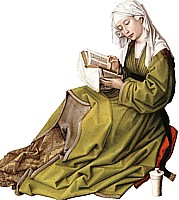 The
houppelande is a specific kind of medieval overgown which was
widely worn in the late 14th century and 15th century. It replaced
the more fitted surcotes and overgowns, although like them, often
showed off the gown underneath which was more costly and expensive. The
houppelande is a specific kind of medieval overgown which was
widely worn in the late 14th century and 15th century. It replaced
the more fitted surcotes and overgowns, although like them, often
showed off the gown underneath which was more costly and expensive.
Technically, it is a surcote because in the earlier medieval
period anything worn as an overgown was usually called a surcote,
but became known as a garment in its own right. 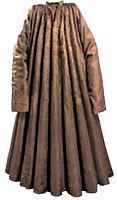
It was always worn with an undergown, never alone.
Shown at right is a detail from the 1445 painting by van der Weyden,
The Magdalene Reading showing Mary in a houppelande which
is folded back to expose her undergown.
Shown at left is an extant houppelande dated to 1396 from the
Czech Republic. It shows a small neck opening and the vast amount
of fabric which creates the folds which we see in contemporary
artworks.

Distinguishing
features
The distinguishing features of the houppelande, were:
- a high collar or neck
opening
- big, loose sleeves
- a voluminous amount of
fabric in the lower part of the gown
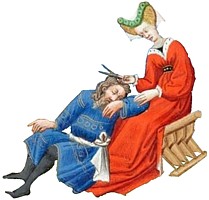 There
were many different sleeve types, but most used a large amount
of fabric compared to previous gowns and fitted kirtles. When
the fabric is gathered high under the bust, it formed pleats in
the fabric. It was always belted under the bust at the back with
a fabric belt which might have expensive decorative metal buckles
and ends. There
were many different sleeve types, but most used a large amount
of fabric compared to previous gowns and fitted kirtles. When
the fabric is gathered high under the bust, it formed pleats in
the fabric. It was always belted under the bust at the back with
a fabric belt which might have expensive decorative metal buckles
and ends.
The houppelande was not constructed with a separate bodice like
some other styles of gown shown on the 15th
CENTURY GOWNS page.
Houppelandes almost always seem to be depicted with a fur lining
and were usually worn with the heart shaped headdress or the horned
headdress and veils.

Sleeve
Styles
 The
styles of the sleeves of the houppelande varied. The
styles of the sleeves of the houppelande varied.
Above at right is a detail from the 1415-1420 illumination, Delilah
Shearing Samsons Hair by the Boucicaut Master from the Bible
Historial from Paris. It shows a bag sleeve which is cut generously
and gathered onto a wrist band. It's called a bag sleeve because
it looks like a bag, and was a style worn by both men and women.
 At
right is a detail of the centre panel from the 1445 painting by
van der Weyden, the Crucifixion Triptych. It shows a woman
in a houppelande lined with grey fur which has a slash in the
bag sleeves. Her sleeves are not excessively long, and she still
wears her sleeve down to the wrist like a regular gown. The slashed
sleeve allows the contrasting colour and fabric of her undergown
to be seen. At
right is a detail of the centre panel from the 1445 painting by
van der Weyden, the Crucifixion Triptych. It shows a woman
in a houppelande lined with grey fur which has a slash in the
bag sleeves. Her sleeves are not excessively long, and she still
wears her sleeve down to the wrist like a regular gown. The slashed
sleeve allows the contrasting colour and fabric of her undergown
to be seen.
At left is a detail from the 1434 painting by Van Eyck, the
Aldolphini Wedding. It shows a young woman wearing a belted
houppeland with extremely long bag sleeves which are also slashed.
She wears her arms through the slash. Unusually, it has rows of
fabric ruffles or purfles which are made from the same
fabric as the houppelande. This is an unusual feature, not seen
in other artworks, and may not have been common.
Sleeves this size would have been quite cumbersome to wear than
those with a cuff at the wrist, so it would have been far more
practical to wear it in this manner. Again, the slashed sleeves
allow the fabric of the undergown to be seen.

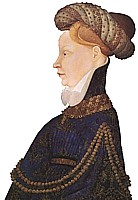 Collar
styles Collar
styles
Styles of collar on the houppelande varied also. Most appear to
have a high-cut standing collar or a wide one folded down to expose
the fur lining around the neck or collarbones.
The detail at right comes from a 1420 painting, Portrait of
a Princess. The woman also wears a sheer fabric between her
neck and the houppelande, although it is unclear exactly what
it is. 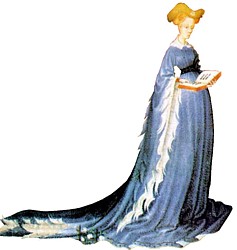 Chemises
did not have collars and neither did the style of undergown worn
at that time. Underneath the sheer fabric, the top of the houppelande
collar can be seen turning down. Chemises
did not have collars and neither did the style of undergown worn
at that time. Underneath the sheer fabric, the top of the houppelande
collar can be seen turning down.
At left, is a manuscript illumination of a woman in a houppelande
with long, wide, daggued sleeves and a high neck. It dates to
pre-1415 and comes from the prayer book of Maria of Gueldern.
The collar is quite wide and worn folded down and the houppelande
itself is worn secured all the way up to the neck.
The daggued sleeves are a decorative feature seen on men's clothing
and hoods and were worn by the upper classes who employed other
people to do their own laundering and were not working at manual
tasks.
This style was not worn by the working classes.

Copyright
© Rosalie Gilbert
All text & photographs within this site are the property of
Rosalie Gilbert unless stated.
Art & artifact images remain the property of the owner.
Images and text may not be copied and used without permission.
|